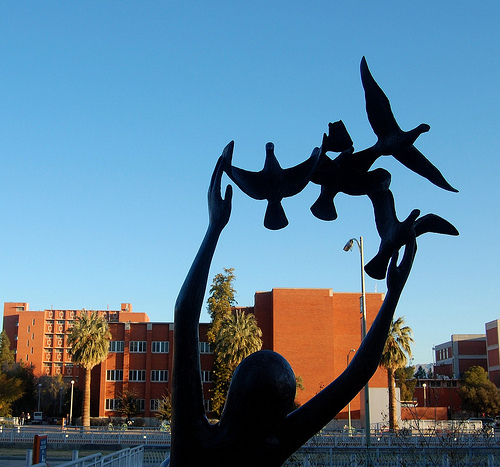With at least four school-choice bills likely on the table this session, Arizona families could see more options in education in the next school year.
Arizona’s education savings accounts (ESAs)—often praised by reformers as being “school choice 2.0″—function much like health savings accounts. Eligible families receive a debit card and can spend their allotted money—90 percent of the state’s per-pupil spending—on private school tuition and fees, private tutoring, curricula, textbooks, education therapy, and other education-related expenses. Money rolls over year-to-year and can go toward college.
Critics say the program is virtually indistinguishable from vouchers, which the state’s highest court struck down in 2009.
Military Families
A previous expansion allowed students of active-duty military families to participate but excluded children whose parents were killed in action and required students to attend public school for a year before becoming ESA eligible.
“Military families are the last-thought-of people when transferring around,” said Rep. Sonny Borrelli (R-Lake Havasu City), who is sponsoring a bill addressing those issues. “Sometimes you’ve got orders to transfer and you’ve got only two, three months to do it, to relocate your family and put them on a waiting list. It’s really hard on those families to adjust.”
Borrelli is a retired Marine, and three of his family members are current or former Marines.
“I saw it happen numerous times—families moving from East Coast to West Coast. I’d see those families struggle,… then go ahead and compound it with a child of a parent killed in action. They move to another state; the grandparents have to watch the kid. So it gets rough.”
Borrelli’s bill would make students of active-duty military families eligible for ESAs without spending a year in public school first, making the transition easier. The bill would also expand ESA eligibility to families of soldiers killed in action.
Special-Needs Students
Students with special needs were the benefactors of the original ESA law, and Rep. David Livingston (R-Peoria) is working on a bill to refine the program to better suit their needs.
Many children entering preschool or kindergarten have only recently been identified as having a disability. Students with disabilities are eligible for ESAs after spending a year in public schools, but that can put them an additional year behind, said Sydney Hay, a government affairs representative for American Federation for Children who has lobbied and worked with Arizona lawmakers on school-choice bills since 1997.
The bill would make siblings of students with disabilities also eligible for ESAs. Some families may drive 25 miles to drop a child off at a school specializing in autism, so it can be a challenge for parents to make sure their other children get to their neighborhood public school on time, Hay said.
The Foundation for Blind Children approached him to suggest the legislation, Livingston said.
Low-Income Students
The details of Rep. Debbie Lesko’s (R-Glendale) bill haven’t been ironed out, but its focus is on expanding ESA eligibility to students who qualify for free or reduced-price lunches.
“My goal is to improve education, and I really don’t think it matters where that education takes place, because every child is different,” Lesko said.
Her own children are thriving in their local public schools, but not every child does, she said.
“Students learn in different environments and in different ways,” she said. “The more alternatives we give parents and their children, the better.”
Her bill may also include eligibility for families of first responders and others.
Lesko has been involved in ESAs since they began, and didn’t sponsor the original 2011 legislation only because she lost a coin toss with another representative who wanted to sponsor it, she said.
District Expansion
Rep. Warren Petersen (R-Gilbert) is working on a bill that would allow school districts to grant every student an ESA, if the school board votes for it.
“I am always interested in ways to expand school choice and empower students and parents with educational options,” he said. “This will allow districts to decide if they want to implement an ESA program.”
He sponsored the bill after a local school district chairwoman approached him about it, he said.
“It’s a complicated bill to craft,” Hay said. “It won’t just involve a percentage of state funding but also of the district funding, so the financial funding mechanism is more complicated.”
Making It Official
The deadline for “dropping” bills—making them official so they can be assigned a bill number and begin the lawmaking process—is Jan. 16.
The state’s ESA program is limited. Only half a percent of the total public school population can join the program each year, which is about 5,600 new ESA students, Hay said. None of the bills lift the cap, though future legislation could. The district expansion bill does not have a cap, Peterson said. Arizona is the first and still only state to offer ESAs.
Hay said she’s excited to see so much expansion proposed this year.
“There’s just tremendous enthusiasm for this program. Folks are realizing that in just its first few years, parents are terrifically satisfied that students are doing well,” Hay said. “Lawmakers are hearing from their families, and it’s just becoming an extremely popular and successful program for being so new.”
Mary C. Tillotson ([email protected]) is a reporter for Watchdog.org, from which this article is reprinted with permission.
Image by UGArdener.




